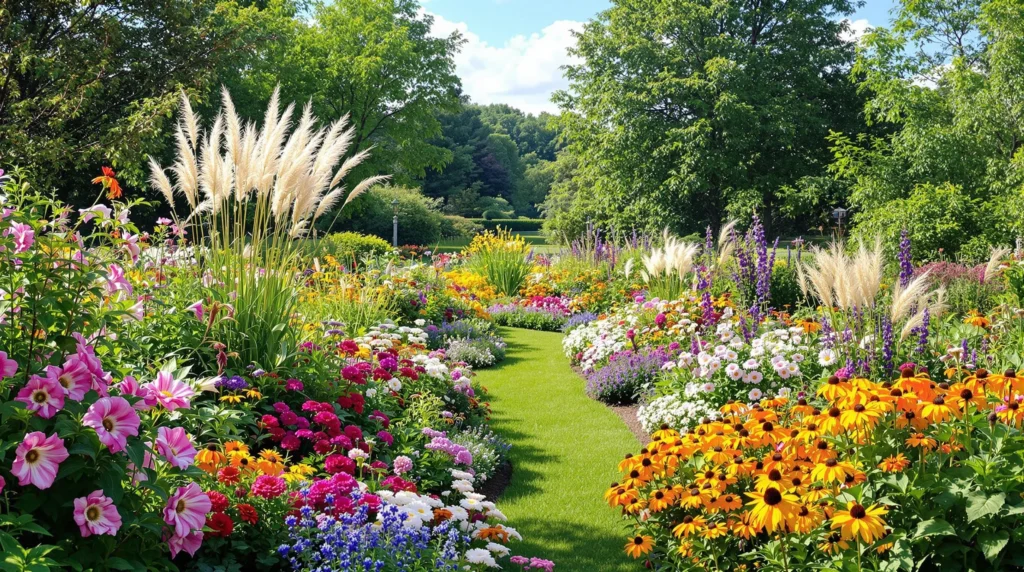12 Stunning Perennial Plants for Year-Round Garden Color
Creating a garden with year-round visual interest requires strategic plant selection. These 12 perennial powerhouses offer beautiful blooms, fascinating foliage, and striking structures across all seasons. From early spring flowers to winter architectural elements, these plants will transform your garden into a continuous display of color and texture.
- Hellebores (Helleborus) – These early bloomers produce elegant flowers from late winter through spring in shades of white, pink, purple, and green. Deer-resistant and shade-tolerant, hellebores thrive in zones 4-9 with minimal maintenance.
- Coral Bells (Heuchera) – Prized for their colorful foliage ranging from purple and burgundy to lime green and amber, coral bells add constant color even when not flowering. Their delicate blooms appear on tall stems in summer, attracting hummingbirds to your garden.
- Black-Eyed Susan (Rudbeckia) – These cheerful golden blooms with dark centers provide reliable summer-to-fall color. Reaching 2-3 feet tall, they’re drought-tolerant once established and create excellent cut flowers for indoor arrangements.
- Russian Sage (Perovskia atriplicifolia) – With silvery-gray foliage and lavender-blue flower spikes, Russian sage offers months of color from midsummer through fall. This drought-tolerant perennial stands 3-4 feet tall and thrives in hot, sunny locations.
- Coneflower (Echinacea) – Available in purple, pink, white, yellow, and orange, these sturdy flowers bloom from summer to fall. Their seedheads provide winter interest and food for birds, making them both beautiful and beneficial.
- Sedum ‘Autumn Joy’ – This succulent perennial features dusty pink flower clusters that deepen to rusty red in fall. Its fleshy foliage looks attractive throughout the growing season, and the dried flower heads add winter structure.
- Ornamental Grasses – Varieties like Miscanthus, Pennisetum, and Panicum provide movement, texture, and sound year-round. Their plumes catch morning dew and winter frost, creating magical garden moments in changing light.
- Baptisia (False Indigo) – With blue, purple, yellow, or white lupine-like flowers in spring, baptisia develops interesting seed pods that persist into winter. Its blue-green foliage forms an attractive shrub-like clump reaching 3-4 feet tall.
- Astilbe – These feathery plume-like flowers in pink, red, lavender, and white brighten shady gardens in early summer. Their fern-like foliage provides texture throughout the growing season, while dried flower heads add winter interest.
- Dianthus (Pinks) – With their spicy fragrance and frilly blooms in pinks, reds, and whites, dianthus offers extended flowering periods from spring through fall with proper deadheading. Their blue-gray foliage remains attractive year-round in mild climates.
- Coreopsis – These daisy-like flowers in yellow, orange, red, or bicolor combinations bloom profusely from early summer through fall if deadheaded. Compact varieties work well in containers while taller types make excellent additions to meadow gardens.
- Japanese Anemone – These elegant flowers on tall, wiry stems bloom in late summer through fall when many perennials have finished flowering. Available in white, pink, and rose, they’re perfect for extending your garden’s season of color.
Choosing the Right Perennial Plants for Four-Season Interest
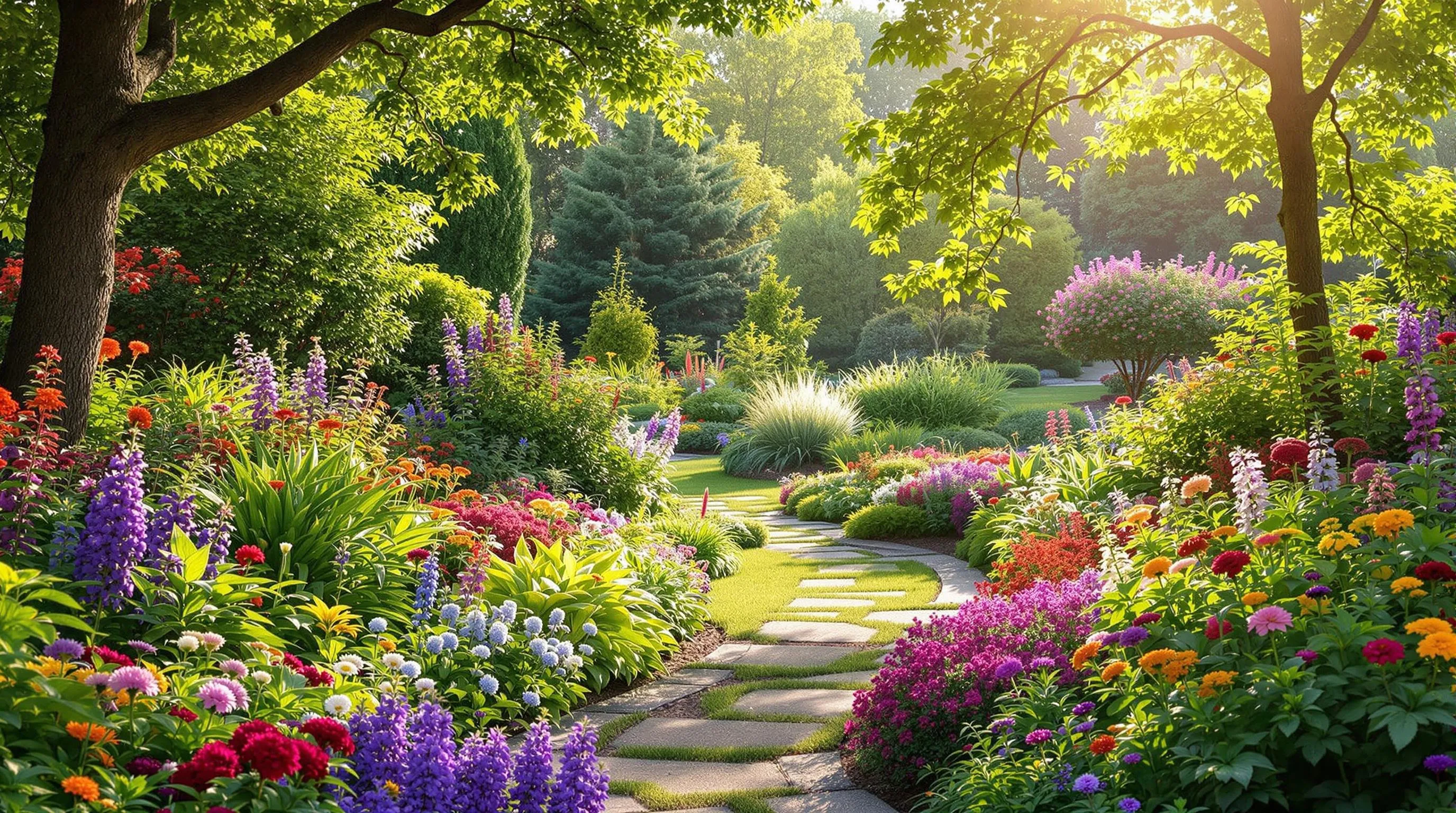
Selecting perennials that provide year-round visual interest requires strategic planning and understanding of plant life cycles. The right combination of plants can ensure your garden remains vibrant across all seasons, not just during peak flowering periods.
Understanding Your Hardiness Zone
Your hardiness zone determines which perennials will thrive in your exact climate. The USDA Plant Hardiness Zone Map divides North America into 13 zones based on average annual minimum winter temperatures. Before purchasing any perennial, check its hardiness rating to ensure it can survive your local winters. Plants labeled for zones 4-9 offer the most versatility across the United States. Consider selecting native perennials for your region as they’re naturally adapted to local conditions, requiring less maintenance and resources. Remember that microclimate variations within your property (such as sheltered areas or frost pockets) might allow you to grow plants from adjacent hardiness zones.
Assessing Your Garden’s Light Conditions
Light exposure significantly impacts plant performance and is crucial for successful four-season gardening. Most perennials have exact light requirements that directly affect their growth, flowering, and overall health. Take time to observe your garden throughout the day, noting which areas receive full sun (6+ hours of direct sunlight), partial sun (4-6 hours), partial shade (2-4 hours), or full shade (less than 2 hours). Create a simple light map of your garden to guide plant placement. Match plants to appropriate light conditions—for example, place sun-lovers like coneflowers and Russian sage in bright spots, while shade-tolerant plants like hellebores and astilbe will thrive in darker areas. Remember that seasonal changes affect light patterns; deciduous trees create shade in summer but allow sunlight through in winter, creating opportunities for spring bulbs and early bloomers.
Early Spring Bloomers That Kick-Start Garden Color
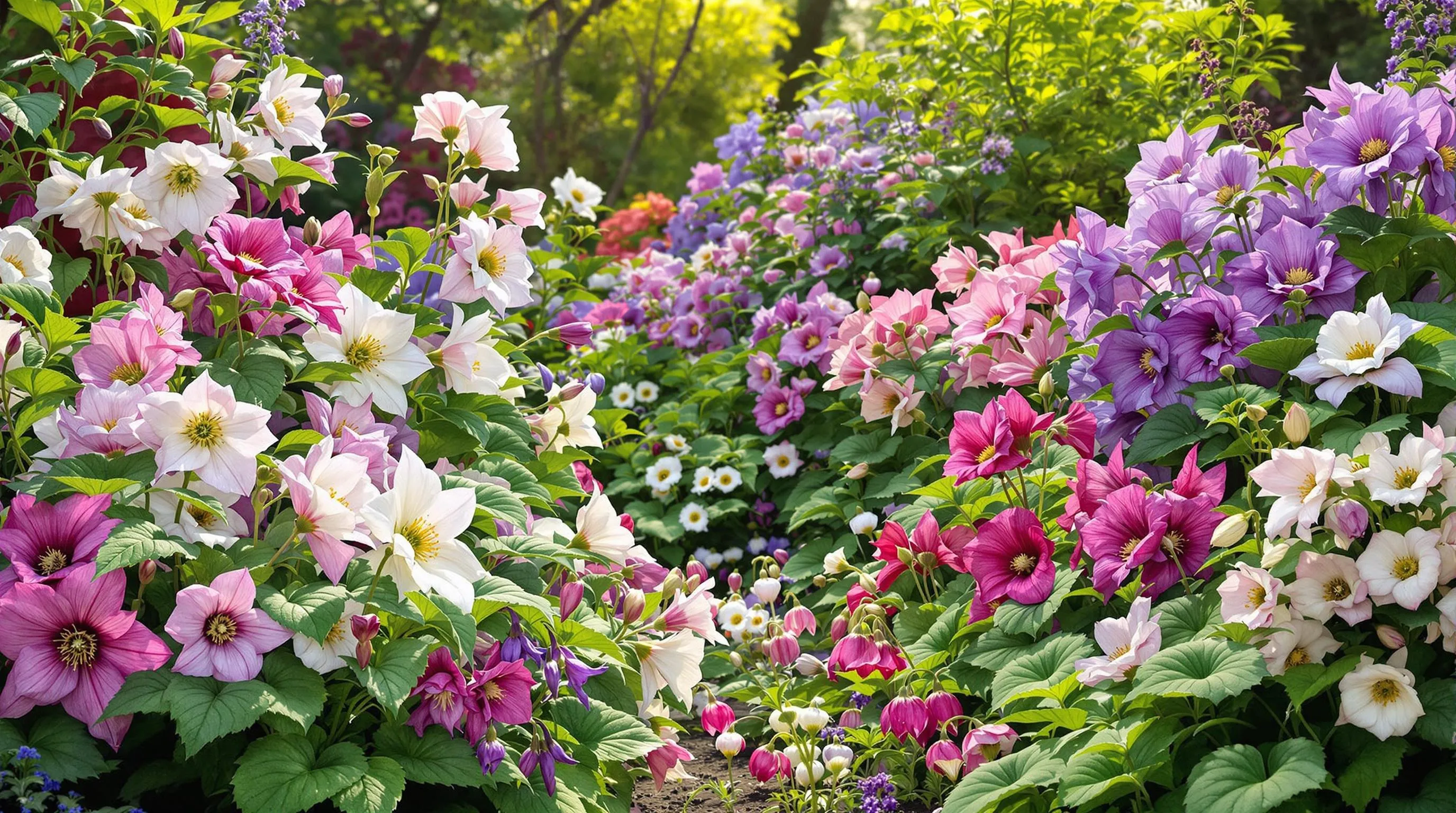
As winter fades, these hardy perennials burst into bloom, bringing the first splashes of color to your garden when you need it most.
Hellebores: The Lenten Rose
Hellebores (Helleborus orientalis) are true garden gems that bloom when most plants remain dormant. These evergreen perennials produce elegant, nodding flowers in shades of white, pink, purple, and green from February through April. Thriving in zones 4-9, hellebores prefer partial to full shade and well-draining soil. Their leathery, deer-resistant foliage maintains visual interest long after the blooms fade. Plant hellebores near walkways or entrances where you’ll appreciate their early color, and pair them with ferns or hostas for striking texture contrast.
Bleeding Hearts: Elegant Woodland Beauties
Bleeding Hearts (Dicentra spectabilis) create a romantic spring display with their distinctive heart-shaped blooms dangling from arching stems. These woodland natives produce pink or white heart-shaped flowers with protruding white tips from April to June in zones 3-9. Growing 2-3 feet tall, Bleeding Hearts prefer partial to full shade and moist, humus-rich soil. While they go dormant in summer heat, their graceful spring presence pairs beautifully with hostas, ferns, and astilbes to maintain garden interest after they retreat. For continuous bloom, try the smaller Dicentra ‘Luxuriant’ variety that flowers from spring through fall.
Summer-Flowering Perennials That Create a Vibrant Display

When summer heat arrives, your garden deserves plants that deliver maximum impact with minimal fuss. These heat-loving perennials thrive during the warmer months, creating spectacular color displays when many spring bloomers have faded.
Coneflowers: Drought-Tolerant Color Machines
Coneflowers (Echinacea) deliver exceptional summer color while requiring minimal care. These native prairie plants produce daisy-like blooms with distinctive raised centers from June through September. Available in a rainbow of colors including purple, pink, white, yellow, and orange, coneflowers attract butterflies and bees while standing strong against summer drought. Plant them in full sun with well-draining soil for best performance. For extended visual interest, leave the seedheads intact after flowering—they’ll feed birds through fall and add structural interest to winter gardens. Pair with ornamental grasses for a naturalistic look that enhances their prairie heritage.
Salvias: Long-Blooming Garden Workhorses
Salvias earn their place in summer gardens with their incredibly long bloom period and remarkable heat tolerance. These aromatic perennials produce spikes of tubular flowers in shades of blue, purple, red, and pink that attract hummingbirds and butterflies from June until frost. Most salvias thrive in full sun and average to dry soil conditions, making them perfect for hot, challenging spots in your garden. Russian sage (Perovskia), a salvia relative, offers silvery foliage and lavender-blue flower spikes that create airy contrast against bolder perennials. For maximum impact, mass salvias in groups of 3-5 plants and deadhead spent blooms to encourage continuous flowering throughout the season.
Fall Stars That Extend the Garden Season

As summer fades, these fall-blooming perennials step into the spotlight, providing crucial late-season color and interest to your garden when most plants are winding down.
Asters: Late-Season Pollinator Magnets
Asters burst onto the scene in late summer and continue blooming well into fall, creating clouds of daisy-like flowers in purple, blue, pink, and white. These hardy perennials reach heights of 1-4 feet depending on the variety, with New England Asters (Symphyotrichum novae-angliae) and New York Asters (Symphyotrichum novi-belgii) being particularly reliable performers. Plant asters in full sun to light shade in well-draining soil, and you’ll be rewarded with a pollinator paradise—butterflies and bees flock to these blooms during a critical time when other nectar sources are scarce. For the best display, pair them with ornamental grasses like Miscanthus or Panicum for a stunning textural contrast.
Japanese Anemones: Elegant Autumn Performers
Japanese Anemones (Anemone hupehensis) bring graceful elegance to the fall garden with their tall, slender stems topped with satiny blooms in white or various shades of pink. These architectural perennials typically flower from August through October, reaching 2-4 feet tall and creating a floating effect above lower-growing plants. They prefer partial shade and consistently moist, rich soil, making them perfect for woodland garden edges or areas that receive morning sun and afternoon shade. Their ability to thrive in spots where other fall bloomers struggle makes them invaluable for extending your garden’s flowering season. For a stunning combination, plant them alongside late-blooming hostas or the burgundy foliage of Heuchera for a sophisticated autumn display.
Winter Interest Perennials for Color During Dormant Months
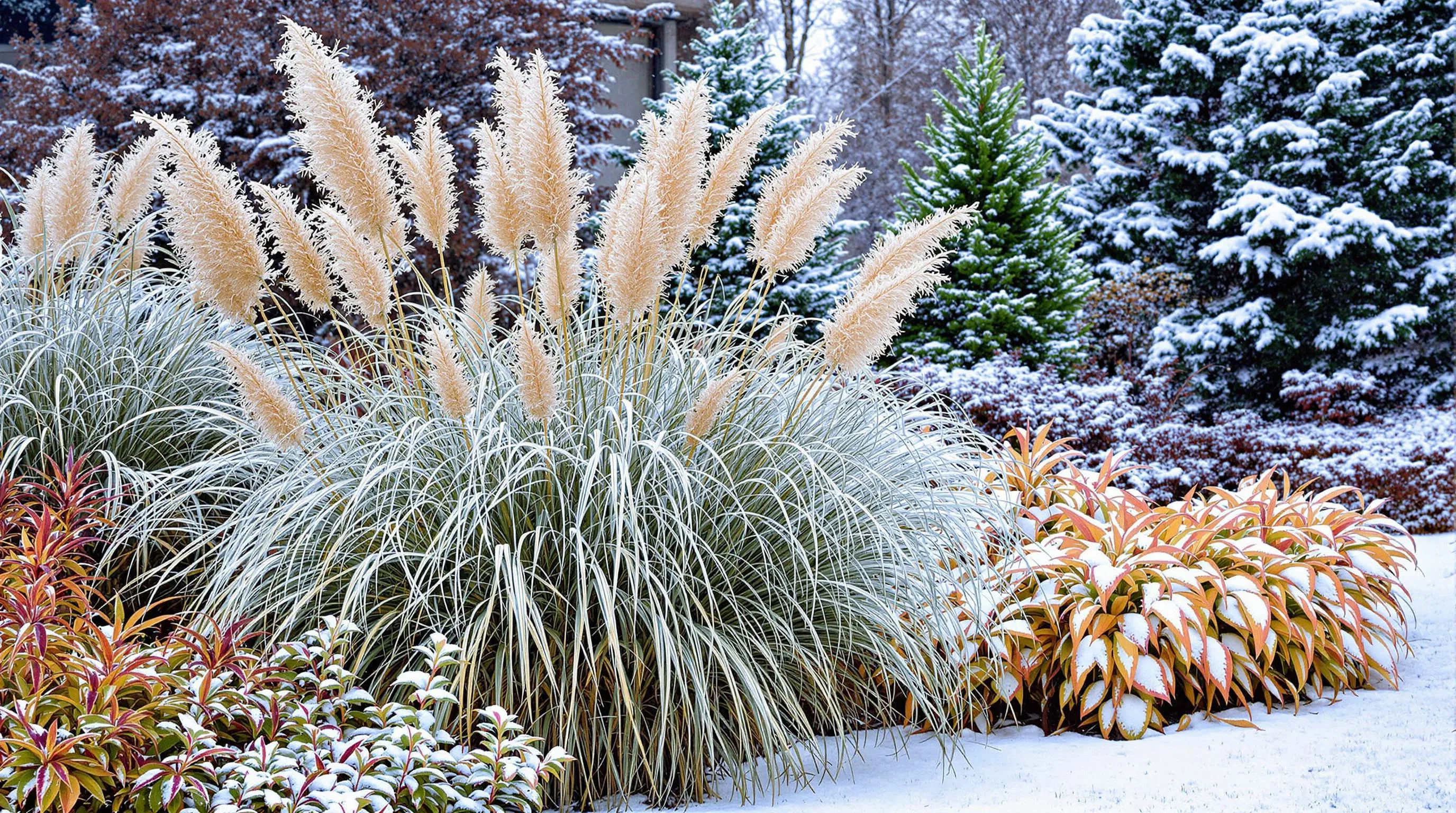
Just because winter brings dormancy doesn’t mean your garden must surrender to drabness. These cold-season heroes provide texture, color, and interest when most plants are sleeping.
Ornamental Grasses: Structural Winter Beauty
Ornamental grasses transform into winter sculptures when frost kisses their plumes. Miscanthus sinensis ‘Morning Light’ creates a stunning vertical statement with its silvery seed heads catching the winter light and snow. Plant Panicum virgatum ‘Shenandoah’ for its burgundy-red foliage that transitions to a warm tan in winter. Little Bluestem (Schizachyrium scoparium) delivers orange-bronze winter color that glows during golden hour. These grasses won’t just stand tall through snow and ice—they’ll dance in winter winds, adding movement to still landscapes. Position them where backlight can illuminate their silhouettes, and leave cutting back until early spring to enjoy their architectural presence all winter.
Evergreen Perennials That Maintain Color Year-Round
Evergreen perennials serve as your garden’s color anchors when deciduous plants have shed their leaves. Heuchera varieties like ‘Palace Purple’ and ‘Caramel’ provide rich burgundy and amber foliage that remains vibrant throughout winter. Bergenia cordifolia, aptly nicknamed “pigsqueak,” features glossy green leaves that often develop stunning magenta-red tones in cold weather. For ground cover, try Epimedium with its leathery, heart-shaped leaves that turn bronze-red in winter, or Helleborus foetidus with its deeply-cut evergreen foliage. Blue fescue (Festuca glauca) offers silver-blue tufts that contrast beautifully with snow. Plant these evergreen perennials strategically among deciduous species to ensure your garden maintains visual interest and color structure when temperatures drop.
Strategic Planting Tips for Continuous Garden Color
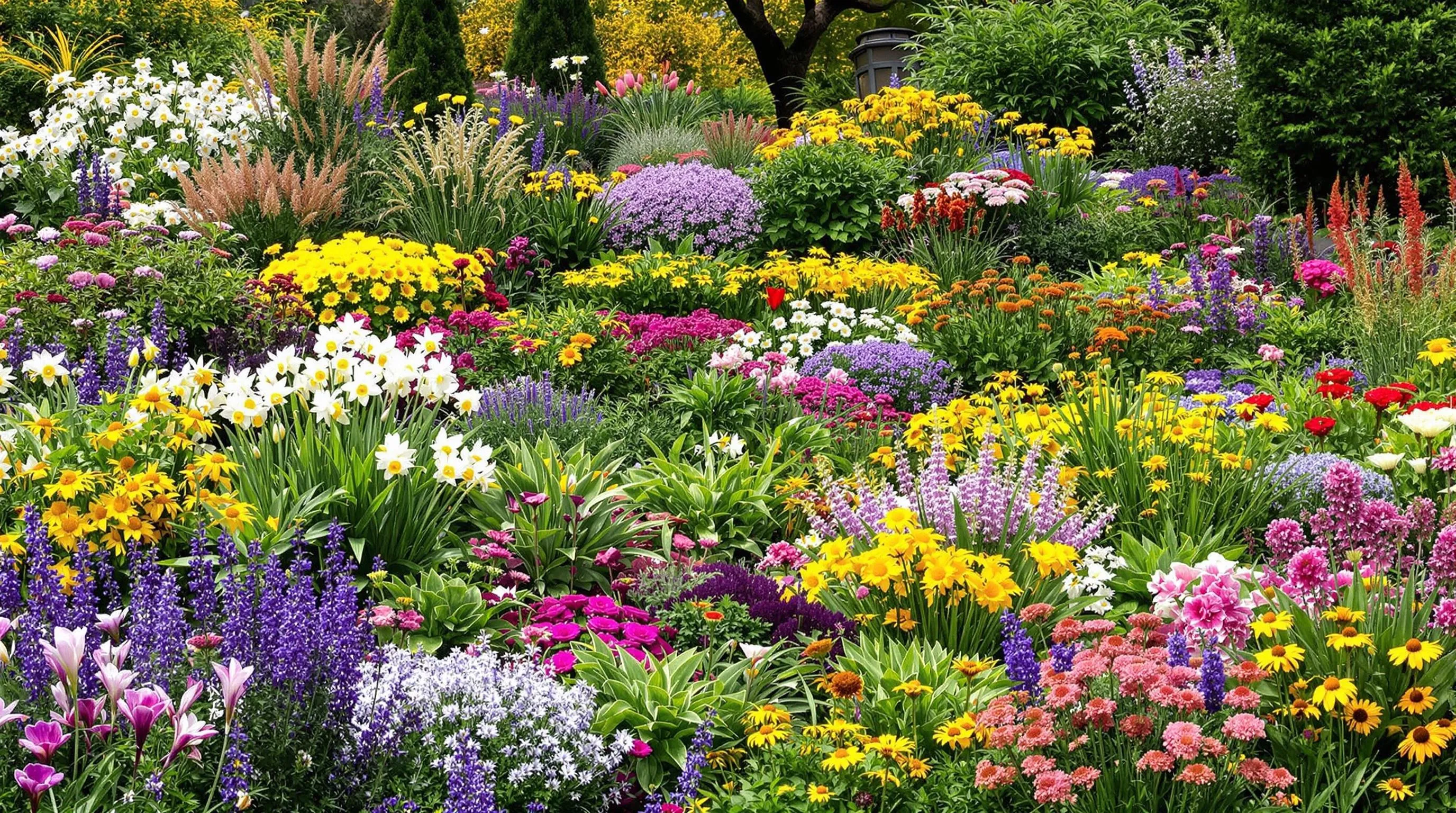
Creating Perennial Combinations That Ensure Seasonal Succession
Strategic plant pairing can transform your garden into a symphony of color that plays year-round. Combine early bloomers like Hellebores with mid-season performers such as Coneflowers and late-season stars like Japanese Anemones to create seamless transitions between seasons. Plant early spring bulbs like Crocus and Daffodils beneath late-emerging perennials like Hostas or Baptisia to maximize space and extend visual interest. Create captivating combinations by mixing plants with complementary colors—try purple Salvias with yellow Coreopsis or pink Dianthus with silver-leaved Russian Sage. Don’t forget to incorporate plants with interesting foliage like Heuchera and ornamental grasses that provide texture when flowers aren’t blooming. Layer your garden by height, placing taller plants like Miscanthus toward the back and lower-growing perennials like Dianthus in front for a ever-changing display visible from all angles.
Maintenance Techniques for Maximizing Bloom Periods
Deadheading spent flowers regularly encourages many perennials like Coreopsis and Salvias to produce additional blooms, significantly extending their flowering season. Practice strategic pruning by cutting back early bloomers like Baptisia and Dianthus by one-third after their first flowering to promote a second flush of blooms. Divide overcrowded perennials every 3-5 years to maintain vigor—spring bloomers in fall and fall bloomers in spring. Apply a balanced slow-release fertilizer in early spring, followed by a phosphorus-rich formula when buds begin forming to support abundant flowering. Mulch beds with 2-3 inches of organic material to regulate soil temperature, conserve moisture, and reduce weed competition that can steal nutrients from your perennials. Carry out a consistent watering schedule, focusing on deep, infrequent irrigation that encourages roots to grow downward and increases drought resistance. Monitor for pests and diseases regularly, as healthy plants produce more abundant blooms and maintain their ornamental value throughout their designated seasons.
Best Perennial Plants for Low-Maintenance Year-Round Color
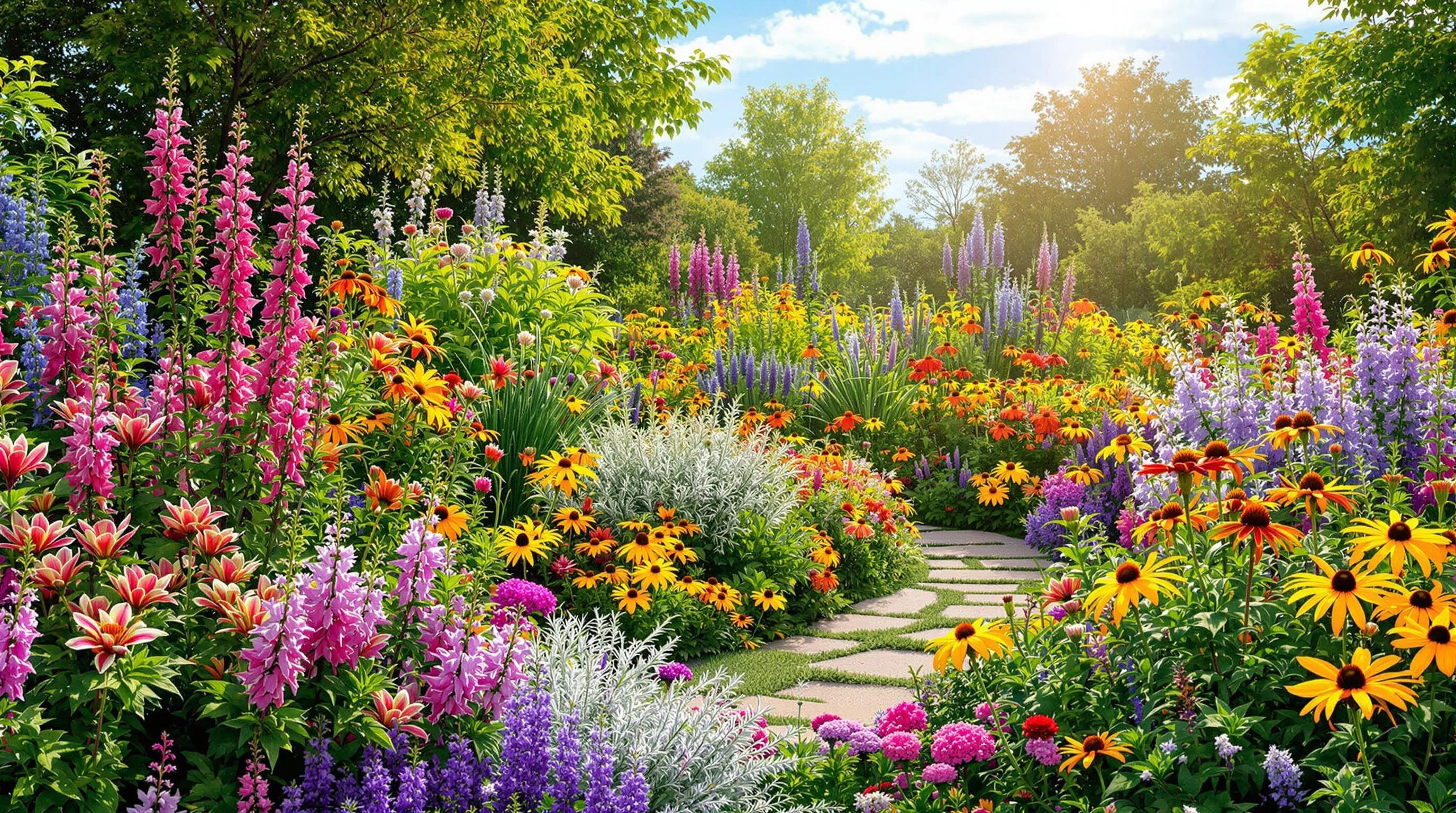
For gardeners seeking beauty without the burden, these low-maintenance perennials deliver maximum visual impact with minimal effort. Sedum ‘Autumn Joy’ thrives in poor soil conditions and rewards with rosy-pink blooms that transform to copper in fall. Daylilies (Hemerocallis) offer a rainbow of colors during summer while requiring virtually no care beyond occasional dividing. Russian Sage (Perovskia atriplicifolia) provides silvery foliage and lavender-blue flower spikes that persist from midsummer through fall, standing strong against drought and poor soil. Yarrow (Achillea) boasts flat-topped flower clusters in yellows, pinks, and whites that bloom for months and dry beautifully for winter interest. Black-eyed Susans (Rudbeckia) brighten late summer gardens with golden blooms that attract pollinators and provide seeds for birds through winter. For shade areas, Japanese Forest Grass (Hakonechloa macra) creates graceful mounds of bright foliage that transitions to copper tones in fall. These resilient performers create a ever-changing industry that transitions seamlessly through seasons while demanding little of your time and resources.
How to Design a Four-Season Perennial Garden That Never Sleeps

Creating a garden that showcases beauty throughout all seasons requires thoughtful planning and strategic plant selection. Start by mapping your garden space and dividing it into “seasonal zones” where spring, summer, fall, and winter interest plants will be prominently featured. Layer your plantings by height, with taller specimens at the back and shorter ones in front for maximum visibility. Incorporate plants with varied bloom times—pair early risers like Hellebores with mid-season Coneflowers and late-blooming Asters. Don’t overlook structural elements; ornamental grasses, evergreen perennials, and plants with interesting seedheads provide winter interest when flowers are scarce. Include a mix of foliage colors and textures to maintain visual appeal between blooming periods. Position your garden where you’ll enjoy it most—near windows or along frequently used walkways—to appreciate the seasonal transitions. Consider microclimates within your garden (sunny spots, shaded areas) and match plants to these conditions. Finally, leave room for spontaneity—about 20% of your garden space should remain flexible for adding new discoveries that extend your garden’s seasonal performance.
Conclusion: Enjoying Your Colorful Perennial Garden All Year
Creating a garden with year-round color isn’t just about pretty flowers—it’s about crafting a living industry that evolves with each passing season. By thoughtfully selecting perennials that shine in different months you’re investing in a sustainable garden that rewards with continuous beauty.
Your perennial garden will become more magnificent with each passing year as plants mature and spread. The strategic combinations of early spring bloomers winter interest plants and summer-to-fall performers create a ever-changing space that’s always offering something new to discover.
Remember that the true joy of a perennial garden is watching it transform through the seasons while requiring less work than annual plantings. With the right plants in the right places you’ll enjoy nature’s ever-changing display right outside your window every day of the year.

